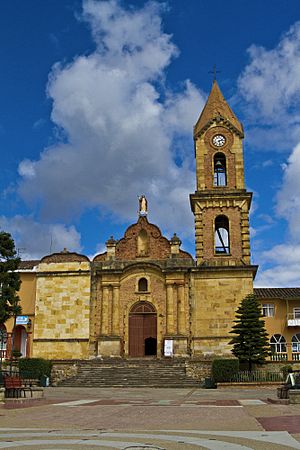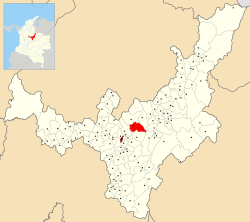Tuta, Boyacá facts for kids
Quick facts for kids
Tuta
|
||
|---|---|---|
|
Municipality and town
|
||

Church of Tuta
|
||
|
||

Location of the municipality and town of Tuta in the Boyacá Department of Colombia
|
||
| Country | ||
| Department | Boyacá Department | |
| Province | Central Boyacá Province | |
| Founded | 4 June 1776 | |
| Founded by | Miguel Sánchez and Juan Rodríguez Parra | |
| Area | ||
| • Municipality and town | 165 km2 (64 sq mi) | |
| • Urban | 0.782 km2 (0.302 sq mi) | |
| Elevation | 2,600 m (8,500 ft) | |
| Population
(2015)
|
||
| • Municipality and town | 9,673 | |
| • Density | 58.62/km2 (151.8/sq mi) | |
| • Urban | 2,665 | |
| Time zone | UTC-5 (Colombia Standard Time) | |
| Website | Official website: http://www.tuta-boyaca.gov.co/ | |
Tuta is a town and a municipality in Colombia. It is located in the Boyacá Department, which is like a state or province. Tuta is part of the Central Boyacá Province.
The town is found on a high plateau called the Altiplano Cundiboyacense. It is about 26 kilometers (16 miles) away from Tunja, the capital city of the Boyacá Department. Tuta shares its borders with several other towns. These include Paipa, Pesca, and Firavitoba to the east. To the west, it borders Cómbita. In the north, you'll find Sotaquirá and Paipa again. Finally, to the south, Tuta borders Chivatá, Toca, and Oicatá.
Contents
Tuta's History
Before the Spanish arrived, the area where Tuta is now was home to the Tuta tribe. These people were part of the Muisca, who lived in a group of independent states called the Muisca Confederation. The northern Muisca lands were ruled by a leader known as the zaque of Hunza. This leader also governed the Tuta tribe.
The Muisca people spoke a language called Chibcha. This language is no longer spoken today. In Chibcha, the word "Tuta" means "Borrowed farmlands" or "Property of the Sun."
The modern town of Tuta was officially founded on June 4, 1776. It was established by two people named Miguel Sánchez and Juan Rodríguez Parra.
What Tuta Produces
The main ways people make a living in Tuta are through farming, raising animals, and mining.
Farming and Livestock
Farmers in Tuta grow many different crops. These include potatoes, barley, beans, maize (corn), peas, and onions. They also grow various fruits. Raising animals, or livestock farming, is also an important part of the local economy.
Mining in Tuta
Tuta is rich in natural resources found underground. People mine for several minerals here, such as gypsum, coal, oil, kaolin, iron ore, and sulphur. Interestingly, emeralds were also discovered on a hill known as the Alto de Ginua.
Famous People from Tuta
Some well-known people were born in Tuta:
- Miguel Samacá: He was a professional cyclist, meaning he rode bikes in races for a living.
- Miguel Ángel Sanabria: He was also a professional cyclist.
- Raúl Sánchez Niño: He is an artist and writes traditional folk music.
Gallery
See also
 In Spanish: Tuta para niños
In Spanish: Tuta para niños








